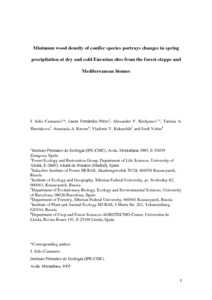Показать сокращенную информацию
Minimum wood density of conifers portrays changes in early season precipitation at dry and cold Eurasian regions
| Автор | Camarero, J. J. | |
| Автор | Fernandez-Perez, L. | |
| Автор | Kirdyanov, A. V. | |
| Автор | Shestakova, T. A. | |
| Автор | Knorre, A. A. | |
| Автор | Kukarskih, V. V. | |
| Автор | Voltas, J. | |
| Дата внесения | 2018-02-07T07:27:04Z | |
| Дата, когда ресурс стал доступен | 2018-02-07T07:27:04Z | |
| Дата публикации | 2017-05 | |
| Библиографическое описание | Camarero, J. J. Minimum wood density of conifers portrays changes in early season precipitation at dry and cold Eurasian regions [Текст] / J. J. Camarero, L. Fernandez-Perez, A. V. Kirdyanov, T. A. Shestakova, A. A. Knorre, V. V. Kukarskih, J. Voltas // Trees - Structure and Function. — 2017. — С. 1-15 | |
| ISSN | 09311890 | |
| URI (для ссылок/цитирований) | https://link.springer.com/article/10.1007/s00468-017-1559-x | |
| URI (для ссылок/цитирований) | https://elib.sfu-kras.ru/handle/2311/69690 | |
| Аннотация | Tracheids fulfil most wood functions in conifers (mechanical support and water transport) and earlywood tracheids account for most hydraulic conductivity within the annual tree ring. Dry conditions during the early growing season, when earlywood is formed, could lead to the formation of narrow tracheid lumens and a dense earlywood. Here, we assessed if there is a negative association between minimum wood density and early growing-season (spring) precipitation. Using dendrochronology, we studied growth and density data at nine forest stands of three Pinaceae species (Larix sibirica, Pinus nigra, and Pinus sylvestris) widely distributed in three cool–dry Eurasian regions from the forest-steppe (Russia, Mongolia) and Mediterranean (Spain) biomes. We measured for each annual tree ring and the common 1950–2002 period the following variables: earlywood and latewood width, and minimum and maximum wood density. As expected, dry early growing season (spring) conditions were associated with low earlywood production but, most importantly, to high minimum density in the three conifer species. The associations between minimum density and spring precipitation were stronger (r = -0.65) than those observed with earlywood width (r = 0.57). We interpret the relationship between spring water availability and high minimum density as a drought-induced reduction in lumen diameter, hydraulic conductivity, and growth. Consequently, forecasted growing-season drier conditions would translate into increased minimum wood density and reflect a reduction in hydraulic conductivity, radial growth, and wood formation. Given the case-study-like nature of this work, more research on other cold–dry sites with additional conifer species is needed to test if minimum wood density is a robust proxy of early season water availability. | |
| Тема | Black pine | |
| Тема | Scots pine | |
| Тема | Siberian larch | |
| Тема | Dendroecology | |
| Тема | Water availability | |
| Тема | Wood density | |
| Название | Minimum wood density of conifers portrays changes in early season precipitation at dry and cold Eurasian regions | |
| Тип | Journal Article | |
| Тип | Journal Article Preprint | |
| Страницы | 1-15 | |
| ГРНТИ | 34.35.17 | |
| Дата обновления | 2018-02-07T07:27:04Z | |
| DOI | 10.1007/s00468-017-1559-x | |
| Институт | Институт экологии и географии | |
| Подразделение | Лаборатория биогеохимии экосистем | |
| Журнал | Trees - Structure and Function | |
| Квартиль журнала в Scopus | Q1 |

